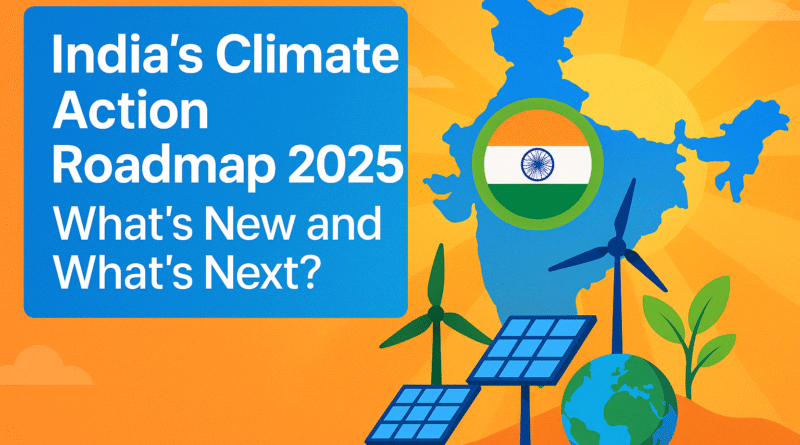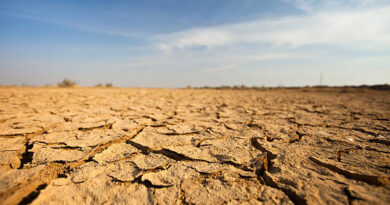India’s Climate Action Roadmap 2025: What’s New and What’s Next?
In 2025, India stands at a pivotal point in its climate journey. As one of the world’s largest and fastest-growing economies, the country faces the dual challenge of sustaining economic development while curbing carbon emissions and protecting vulnerable communities. With the effects of climate change becoming increasingly visible—through rising temperatures, erratic monsoons, and worsening air quality—India’s updated climate action roadmap is more relevant and urgent than ever.
This blog breaks down India’s Climate Action Roadmap 2025, highlights key takeaways from COP28, and explores what lies ahead as the country steers its sustainable development strategy.
🌍 Where We Stand: Climate Challenges in India
Before diving into the roadmap, it’s essential to understand the context. India contributes about 7% of global greenhouse gas (GHG) emissions, ranking third after China and the U.S. Yet, on a per capita basis, its emissions are relatively low. Still, the country is one of the most vulnerable to climate-related disruptions:
Water stress affecting agriculture and urban supply
Increasing heatwaves in northern and central India
Rising sea levels threatening coastal cities like Mumbai and Chennai
Air pollution reaching hazardous levels in urban centers
India’s response must be both resilient and inclusive, balancing economic growth, energy needs, and environmental protection.
📝 Updated NDCs: India’s 2022-2030 Commitments
India’s latest Nationally Determined Contributions (NDCs)—submitted under the Paris Agreement—set the stage for 2025’s roadmap. They include:
Reducing Emissions Intensity
A 45% reduction in GDP-linked emissions intensity by 2030 (compared to 2005 levels).
Increasing Renewable Energy Capacity
Target: 50% of cumulative electric power installed capacity to come from non-fossil fuel sources by 2030.
Carbon Sink Enhancement
Create additional 2.5 to 3 billion tonnes of CO₂ equivalent through afforestation and reforestation efforts.
Transitioning to Cleaner Fuels
Promotion of green hydrogen, ethanol blending, and natural gas as key alternatives to coal and oil.
🌐 India at COP28: Key Takeaways
India’s presence at COP28 (held in Dubai, UAE) was notable for its leadership in pushing for equitable climate finance and technology access. Here’s what India advocated for—and secured:
1. Climate Finance Commitments
India strongly pushed for operationalizing the Loss and Damage Fund, a global initiative to support vulnerable nations. In response, developed countries pledged more than $700 million to the fund by early 2025, though India continues to press for faster disbursement.
2. Technology Transfer
India emphasized fair access to clean technologies, such as carbon capture and green hydrogen production. In 2025, the country launched joint tech hubs with countries like Germany, Japan, and Australia to accelerate low-carbon innovation.
3. Phase-Down of Fossil Fuels
India reiterated its position on a “just transition”, emphasizing that developing nations need longer timelines and financial support to move away from coal without hampering economic growth.
🛠️ Key Pillars of India’s Climate Action Roadmap 2025
India’s updated climate strategy builds on the NDCs with a focused set of programs and regulatory measures. Here are the five core pillars shaping the roadmap:
1. ☀️ Renewable Energy Expansion
India aims to install 500 GW of non-fossil fuel capacity by 2030. As of mid-2025, nearly 230 GW has already been achieved, driven by:
Solar Parks in Rajasthan, Gujarat, and Ladakh
Wind Energy growth in Tamil Nadu and Maharashtra
Rooftop solar subsidies for urban and rural households
New in 2025: The PM Suryodaya Yojana, launched in January, offers free rooftop solar systems to low-income households, reducing dependence on coal-powered electricity.
2. 🚗 Green Transport Revolution
Transport contributes 10% of India’s GHG emissions. The 2025 roadmap addresses this with:
EV penetration targets: 30% of all new vehicle sales to be electric by 2030
Public transit electrification in cities like Delhi, Bengaluru, and Kochi
Investment in hydrogen-powered buses for intercity travel
New Policy: The National Electric Mobility Mission 2.0, introduced this year, includes battery-swapping infrastructure and tax rebates for EV manufacturers.
3. 🏭 Industrial Decarbonization
High-emission sectors like cement, steel, and fertilizers are under pressure to clean up. India’s 2025 strategy includes:
Green hydrogen pilots in steel manufacturing
Carbon pricing discussions (initial proposals under review by NITI Aayog)
Mandatory energy audits for large factories
Notable Milestone: Tata Steel’s first green hydrogen furnace, inaugurated in Odisha, is now fully operational and could reduce emissions by up to 20% per tonne.
4. 🌳 Climate-Resilient Agriculture
Climate-smart agriculture is central to India’s food security. New efforts include:
Millet missions to promote drought-resistant crops
Precision irrigation using AI and IoT (e.g., micro-drip systems)
Agroforestry subsidies to increase green cover on farmland
New Initiative: The “Green Gram Panchayats” program now includes over 1,000 villages adopting eco-farming and organic waste composting practices in 2025.
5. 🏘️ Urban Resilience and Green Infrastructure
As cities grow, India is investing in climate-proof urban design:
Cool roof policies in Hyderabad and Ahmedabad
Expansion of urban green belts
Smart stormwater management systems
Big Win: Mumbai’s Climate Action Plan, rolled out citywide in 2025, now integrates climate risk zones into municipal planning, protecting vulnerable slums from floods.
🧮 Financing the Climate Agenda
India estimates a need for $10 trillion by 2070 to meet its climate goals. To get there, several financing tools have gained traction in 2025:
Green Bonds issued by RBI and leading banks
Sustainability-linked loans for clean tech startups
Creation of India’s Climate Investment Platform for global investors
The G20 Delhi Summit in 2023 also laid the groundwork for multilateral green finance pipelines, many of which are now in implementation.
📊 Tracking Progress: What’s Measured Gets Managed
India is adopting data-driven approaches to climate accountability:
State-wise climate dashboards
Carbon credit registries under the new Carbon Market Policy
Remote sensing tools to track deforestation and pollution
By 2025, 11 states now publish real-time data on emission sources and climate adaptation projects via open public dashboards.
🌟 What’s Next?
Looking ahead, here are India’s most anticipated moves in the second half of 2025 and beyond:
Finalization of the Carbon Pricing Mechanism
Expansion of Green Hydrogen Mission Phase 2
Launch of Climate Adaptation Funds for vulnerable districts
India’s first Net-Zero Industrial Cluster, likely in Gujarat or Maharashtra
💬 Final Thoughts
India’s climate action roadmap in 2025 represents a bold yet practical shift toward sustainability. By blending policy reform, grassroots innovation, international collaboration, and climate justice, the country is not only safeguarding its future but also setting an example for other emerging economies.
India is proving that climate action is not a burden—it’s an opportunity to reimagine growth, empower communities, and restore ecosystems. The road ahead is long, but the wheels are turning faster than ever.




